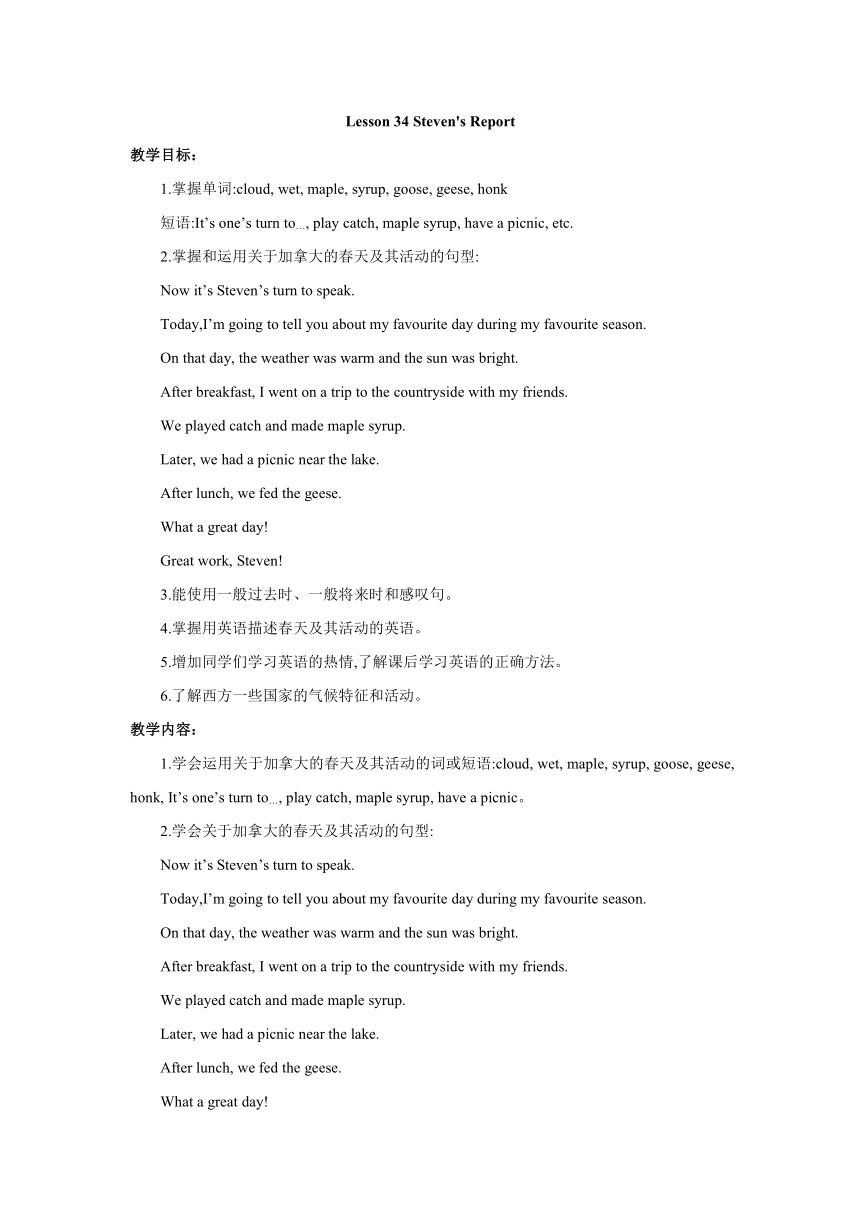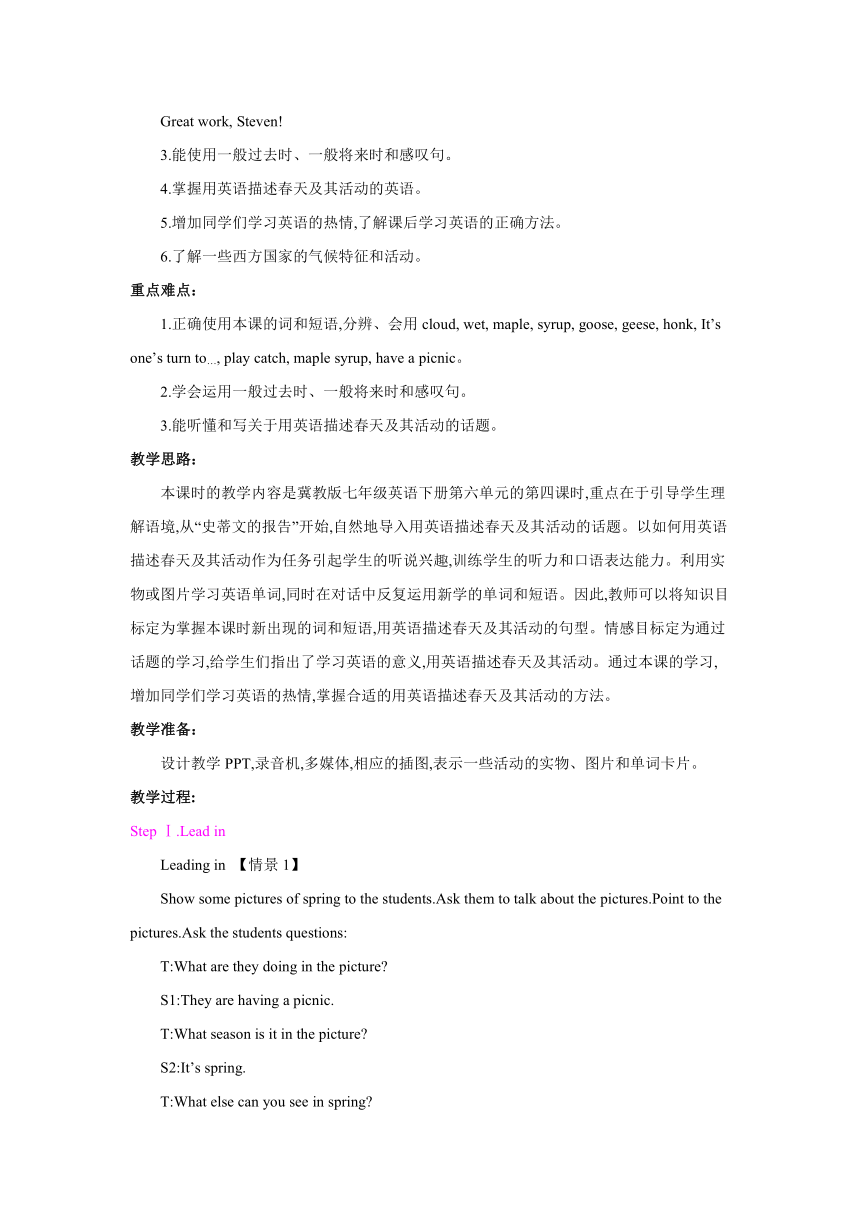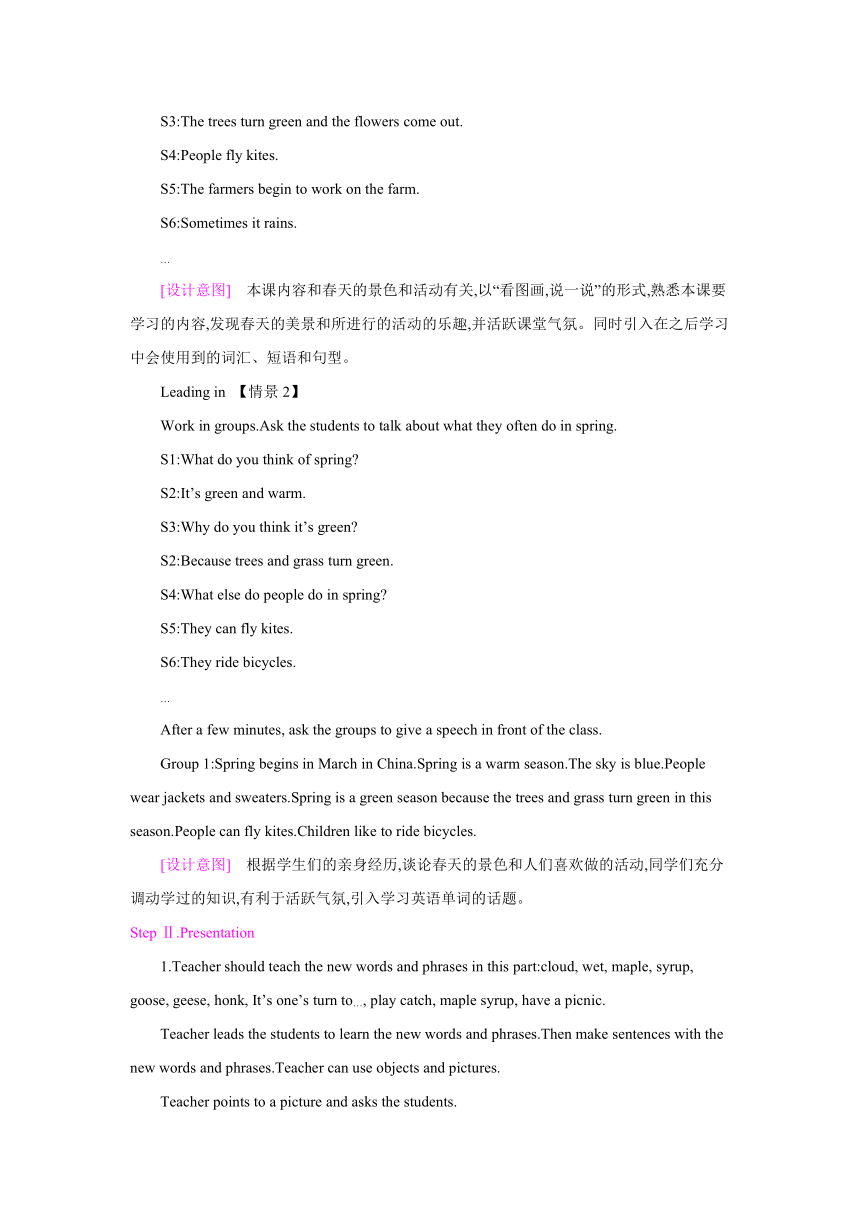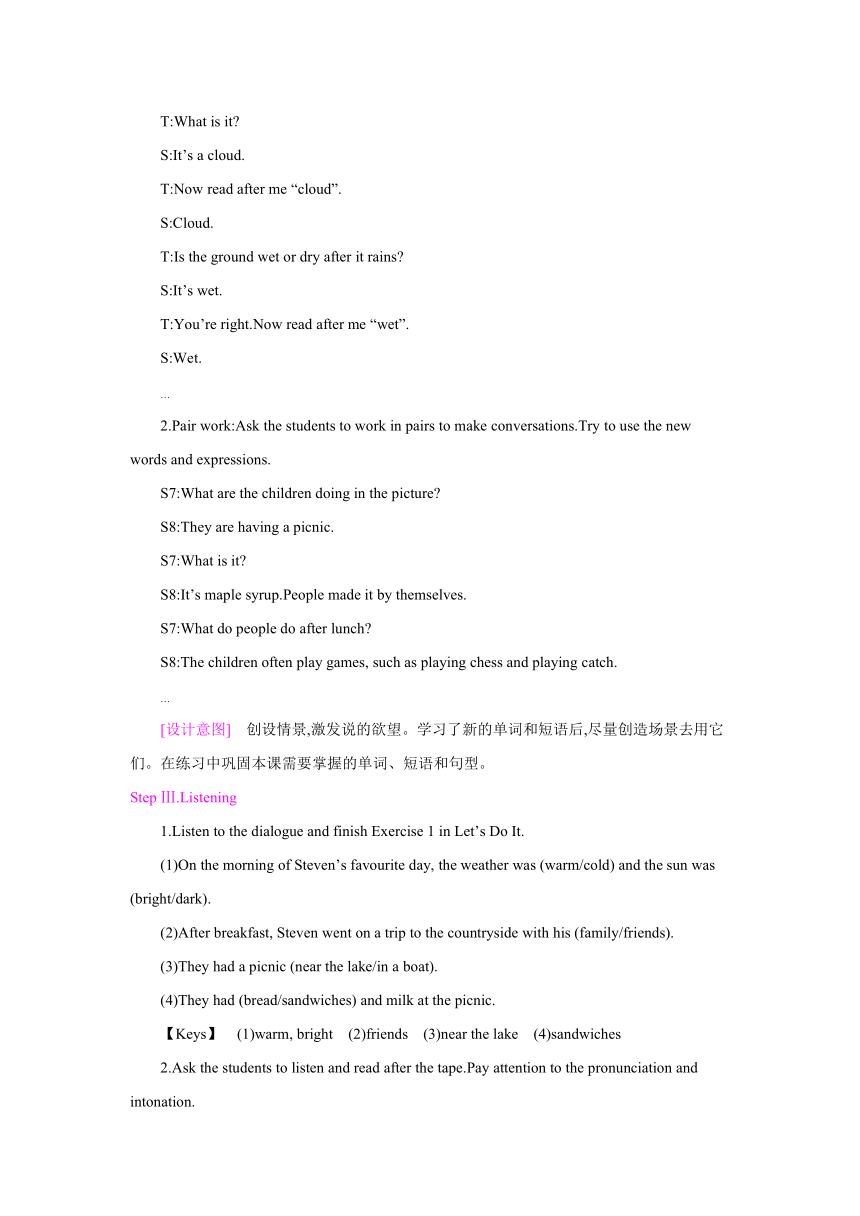Unit 6 Seasons Lesson 34 Steven’s Report 教学设计
文档属性
| 名称 | Unit 6 Seasons Lesson 34 Steven’s Report 教学设计 |

|
|
| 格式 | zip | ||
| 文件大小 | 28.3KB | ||
| 资源类型 | 教案 | ||
| 版本资源 | 冀教版 | ||
| 科目 | 英语 | ||
| 更新时间 | 2019-06-27 16:52:39 | ||
图片预览




文档简介
Lesson 34 Steven's Report
教学目标:
1.掌握单词:cloud, wet, maple, syrup, goose, geese, honk
短语:It’s one’s turn to…, play catch, maple syrup, have a picnic, etc.
2.掌握和运用关于加拿大的春天及其活动的句型:
Now it’s Steven’s turn to speak.
Today,I’m going to tell you about my favourite day during my favourite season.
On that day, the weather was warm and the sun was bright.
After breakfast, I went on a trip to the countryside with my friends.
We played catch and made maple syrup.
Later, we had a picnic near the lake.
After lunch, we fed the geese.
What a great day!
Great work, Steven!
3.能使用一般过去时、一般将来时和感叹句。
4.掌握用英语描述春天及其活动的英语。
5.增加同学们学习英语的热情,了解课后学习英语的正确方法。
6.了解西方一些国家的气候特征和活动。
教学内容:
1.学会运用关于加拿大的春天及其活动的词或短语:cloud, wet, maple, syrup, goose, geese, honk, It’s one’s turn to…, play catch, maple syrup, have a picnic。
2.学会关于加拿大的春天及其活动的句型:
Now it’s Steven’s turn to speak.
Today,I’m going to tell you about my favourite day during my favourite season.
On that day, the weather was warm and the sun was bright.
After breakfast, I went on a trip to the countryside with my friends.
We played catch and made maple syrup.
Later, we had a picnic near the lake.
After lunch, we fed the geese.
What a great day!
Great work, Steven!
3.能使用一般过去时、一般将来时和感叹句。
4.掌握用英语描述春天及其活动的英语。
5.增加同学们学习英语的热情,了解课后学习英语的正确方法。
6.了解一些西方国家的气候特征和活动。
重点难点:
1.正确使用本课的词和短语,分辨、会用cloud, wet, maple, syrup, goose, geese, honk, It’s one’s turn to…, play catch, maple syrup, have a picnic。
2.学会运用一般过去时、一般将来时和感叹句。
3.能听懂和写关于用英语描述春天及其活动的话题。
教学思路:
本课时的教学内容是冀教版七年级英语下册第六单元的第四课时,重点在于引导学生理解语境,从“史蒂文的报告”开始,自然地导入用英语描述春天及其活动的话题。以如何用英语描述春天及其活动作为任务引起学生的听说兴趣,训练学生的听力和口语表达能力。利用实物或图片学习英语单词,同时在对话中反复运用新学的单词和短语。因此,教师可以将知识目标定为掌握本课时新出现的词和短语,用英语描述春天及其活动的句型。情感目标定为通过话题的学习,给学生们指出了学习英语的意义,用英语描述春天及其活动。通过本课的学习,增加同学们学习英语的热情,掌握合适的用英语描述春天及其活动的方法。
教学准备:
设计教学PPT,录音机,多媒体,相应的插图,表示一些活动的实物、图片和单词卡片。
教学过程:
Step Ⅰ.Lead in
Leading in 【情景1】
Show some pictures of spring to the students.Ask them to talk about the pictures.Point to the pictures.Ask the students questions:
T:What are they doing in the picture?
S1:They are having a picnic.
T:What season is it in the picture?
S2:It’s spring.
T:What else can you see in spring?
S3:The trees turn green and the flowers come out.
S4:People fly kites.
S5:The farmers begin to work on the farm.
S6:Sometimes it rains.
…
[设计意图] 本课内容和春天的景色和活动有关,以“看图画,说一说”的形式,熟悉本课要学习的内容,发现春天的美景和所进行的活动的乐趣,并活跃课堂气氛。同时引入在之后学习中会使用到的词汇、短语和句型。
Leading in 【情景2】
Work in groups.Ask the students to talk about what they often do in spring.
S1:What do you think of spring?
S2:It’s green and warm.
S3:Why do you think it’s green?
S2:Because trees and grass turn green.
S4:What else do people do in spring?
S5:They can fly kites.
S6:They ride bicycles.
…
After a few minutes, ask the groups to give a speech in front of the class.
Group 1:Spring begins in March in China.Spring is a warm season.The sky is blue.People wear jackets and sweaters.Spring is a green season because the trees and grass turn green in this season.People can fly kites.Children like to ride bicycles.
[设计意图] 根据学生们的亲身经历,谈论春天的景色和人们喜欢做的活动,同学们充分调动学过的知识,有利于活跃气氛,引入学习英语单词的话题。
Step Ⅱ.Presentation
1.Teacher should teach the new words and phrases in this part:cloud, wet, maple, syrup, goose, geese, honk, It’s one’s turn to…, play catch, maple syrup, have a picnic.
Teacher leads the students to learn the new words and phrases.Then make sentences with the new words and phrases.Teacher can use objects and pictures.
Teacher points to a picture and asks the students.
T:What is it?
S:It’s a cloud.
T:Now read after me “cloud”.
S:Cloud.
T:Is the ground wet or dry after it rains?
S:It’s wet.
T:You’re right.Now read after me “wet”.
S:Wet.
…
2.Pair work:Ask the students to work in pairs to make conversations.Try to use the new words and expressions.
S7:What are the children doing in the picture?
S8:They are having a picnic.
S7:What is it?
S8:It’s maple syrup.People made it by themselves.
S7:What do people do after lunch?
S8:The children often play games, such as playing chess and playing catch.
…
[设计意图] 创设情景,激发说的欲望。学习了新的单词和短语后,尽量创造场景去用它们。在练习中巩固本课需要掌握的单词、短语和句型。
Step Ⅲ.Listening
1.Listen to the dialogue and finish Exercise 1 in Let’s Do It.
(1)On the morning of Steven’s favourite day, the weather was (warm/cold) and the sun was (bright/dark).
(2)After breakfast, Steven went on a trip to the countryside with his (family/friends).
(3)They had a picnic (near the lake/in a boat).
(4)They had (bread/sandwiches) and milk at the picnic.
【Keys】 (1)warm, bright (2)friends (3)near the lake (4)sandwiches
2.Ask the students to listen and read after the tape.Pay attention to the pronunciation and intonation.
[设计意图] 加深同学们对细节的掌握,学生们在有了一定的信息输入之后,才能在这一部分写出所缺信息。
Step Ⅳ.Reading
1.Read the lesson and answer the following questions.
(1)What was the weather like on that day?
(2) Where did they have a picnic?
(3) When did it begin to rain?
【Keys】 (1)It was warm and the sun was bright.
(2)Near the lake.
(3)After lunch.
2.Read the text; ask and answer questions.
Group work:Read the text first, then ask at least 3 questions.After a while, you can ask anyone in the class to answer the questions.
Group 1:
(1) Did they make maple syrup?
(2) What did they have for lunch?
(3) What did they do after lunch?
【Keys】 (1)Yes, they did.
(2) They had sandwiches and milk.
(3)They fed the geese.
3.Ask the students to read the text.
T:Now let’s read the text.At the same time, pay attention to the pronunciation and intonation.
Ask some students to read aloud in class.
T:Now let’s see who can read best.
4.Read and find the key points.
The following language points should be explained.
☆教材解读☆
1.Now it’s Steven’s turn to speak.?
It’s one’s turn to do sth.轮到某人做某事。这里turn为名词,表示“次序”。
It’s our turn to clean the classroom today.
今天轮到我们打扫教室了。
It’s Lucy’s turn to water the flowers.
该轮到露西浇花了。
【拓展】 (1)turn构成的句型还有:Take turns to do sth.轮流做某事。
We take turns to clean the blackboard.
我们轮流擦黑板。
(2)turn用作动词,意为“转动,翻转”。
The earth turns around itself.地球自转。
2.Later, we had a picnic near the lake.?
have a picnic野餐。have 可构成许多短语:have a cold 感冒;have a talk 谈话;have a meeting 开会;have a rest 休息;have a headache 头疼。
Where did they have a picnic last week?
上周他们在哪儿野餐了?
【拓展】 go for a picnic 意为“去野餐”。
Let’s go for a picnic!咱们去野餐吧!
3.After lunch,we fed the geese.?
feed“喂养,饲养”,过去式fed,用法如下:
(1)feed…to中的feed是及物动词,其后接饲料或食物名词作宾语,to为介词,其后一般接动物或小孩等名词表示对象,其词组意思是“把……喂给……吃”。
Please feed some grass to the cow.
请给牛喂点草。
(2)feed…on 中的feed也是及物动词,其后接人或动物名词作宾语, on后接食物或饲料名词,其词组表示“用……喂……”。on可与with 替换。
The child was feeding the monkey on/with a banana.那孩子用香蕉喂猴子。
(3)feed on中的feed为不及物动词,意思是“食,吃”(主要指动物,若指人则为口语或诙谐用语),与介词on连用,其词组意思是“以……为食,靠……为生”,其主语主要用来指动物,也可用于指婴儿,其宾语通常是食物或饲料名词。
Cows feed on grass.牛以草为食。
4.There were many clouds.?
cloud可用作名词,既可作可数名词也可作不可数名词, 意为“云”。
Dark clouds are a sign of rain.
乌云是下雨的征兆。
【拓展】 cloud加-y,构成形容词cloudy,意为“多云的,阴天的”,类似的变化还有:
sun → sunny晴朗的 rain → rainy 有雨的 snow →snowy有雪的 wind→ windy 有风的
5.Let’s give him a big hand...?
give sb.sth.=give sth.to sb.意为“把某物给某人”。
Please give me a cup of tea.
=Please give a cup of tea to me.
请给我一杯茶。
【注意】 当直接宾语是代词时,只用 give sth.to sb.这一结构。
Can you give it to me?你能把它给我吗?
[设计意图] 朗读比赛能激发学生的读书欲望,给学生们提供展示的机会。读书找到关键信息这个任务,能提高同学们的阅读理解能力。
StepⅤ.Practice
1.Ask the students to retell the story with their own words.
2.Work group:Talk about one of your trips.Now discuss for several minutes.Then ask some groups to show their reports.
3.Ask the students to make sentences with the new words, expressions and patterns.
[设计意图] “学为所用”,模仿本课内容,谈论你最喜欢的旅行,培养学生运用目标语言进行交际的能力。重述故事考查同学们对课文细节的理解和记忆。
Step Ⅵ.Complete Let’s Do It!
We have finished Exercise 1 in listening part.Exercise 2 is reading part.Ask the students to finish Exercise 2 and Exercise 3 by themselves.Check the answers in class.
[设计意图] Let’s Do It!部分中的Exercise 1是听力教学,我们在课上在听力部分完成了任务。Exercise 2是阅读教学,让同学们自主完成。Exercise 3主要考查同学们对本课单词、短语和句型的熟练程度。
Step Ⅶ.Task
Finish Exercise 4 in pairs.
Work in pairs.Talk about your favourite day or a special day.What season was it in? How was the weather? What happened on that day? Write a story about it and share it with the class.
[设计意图] Exercise 4提供给同学们一个练习本课单词、短语和句型的机会,给同学们时间练习,给他们展示的机会,这是本课内容的升华。
Step Ⅷ.Exercises
Fill in the blanks.
1.我和朋友们一起到乡村旅游。
I to the countryside my friends.?
2.天开始下雨!
It rain! ?
3.我们全湿了!
We wet!?
4.同学们,让我们为他大声鼓掌。
Let’s give him , class.?
5.我们跑向汽车,但是太晚了。
We the car, but it was too late.?
【Keys】 1.went on a trip, with 2.began to 3.were all 4.a big hand 5.ran to
[设计意图] 以学评教、强化落实。当堂检测主要是由本节内容组成的形成性评价,检测当堂学习效果。
Step Ⅸ.Homework
1.Learn the new words and expressions by heart.
2.Find out what people often do in spring in Canada.
3.Prepare for the next lesson.
[设计意图] “学为所用”,课上学习的知识要在课下充分练习,才能真正掌握。
Lesson 34 Steven’s Report
cloud, wet, maple, syrup, goose,
geese, honk, It’s one’s turn to…, play catch,
maple syrup, have a picnic
What a great day!
We played catch and made maple syrup.
Great work, Steven!
Later, we had a picnic near the lake.
After lunch, we fed the geese.
Now it’s Steven’s turn to speak.
On that day, the weather was warm and the sun was bright.
After breakfast, I went on a trip to the countryside with my friends.
Today,I’m going to tell you about my favourite day during my favourite season.
教材习题解答
【Keys】
2
Steven’s Favourite Day
Time
Weather
Activities
After breakfast
The weather was warm.
The sun was bright.
He went on a trip to the countryside with his friends.
They played catch and made maple syrup.
They had a picnic near the lake.
After lunch
The sky became dark.There were many clouds.It began to rain.
They fed the geese.They ran to the car, but it was too late.They were all wet!
3 1.laughed 2.dark 3.wet 4.clouds 5.catch
教学目标:
1.掌握单词:cloud, wet, maple, syrup, goose, geese, honk
短语:It’s one’s turn to…, play catch, maple syrup, have a picnic, etc.
2.掌握和运用关于加拿大的春天及其活动的句型:
Now it’s Steven’s turn to speak.
Today,I’m going to tell you about my favourite day during my favourite season.
On that day, the weather was warm and the sun was bright.
After breakfast, I went on a trip to the countryside with my friends.
We played catch and made maple syrup.
Later, we had a picnic near the lake.
After lunch, we fed the geese.
What a great day!
Great work, Steven!
3.能使用一般过去时、一般将来时和感叹句。
4.掌握用英语描述春天及其活动的英语。
5.增加同学们学习英语的热情,了解课后学习英语的正确方法。
6.了解西方一些国家的气候特征和活动。
教学内容:
1.学会运用关于加拿大的春天及其活动的词或短语:cloud, wet, maple, syrup, goose, geese, honk, It’s one’s turn to…, play catch, maple syrup, have a picnic。
2.学会关于加拿大的春天及其活动的句型:
Now it’s Steven’s turn to speak.
Today,I’m going to tell you about my favourite day during my favourite season.
On that day, the weather was warm and the sun was bright.
After breakfast, I went on a trip to the countryside with my friends.
We played catch and made maple syrup.
Later, we had a picnic near the lake.
After lunch, we fed the geese.
What a great day!
Great work, Steven!
3.能使用一般过去时、一般将来时和感叹句。
4.掌握用英语描述春天及其活动的英语。
5.增加同学们学习英语的热情,了解课后学习英语的正确方法。
6.了解一些西方国家的气候特征和活动。
重点难点:
1.正确使用本课的词和短语,分辨、会用cloud, wet, maple, syrup, goose, geese, honk, It’s one’s turn to…, play catch, maple syrup, have a picnic。
2.学会运用一般过去时、一般将来时和感叹句。
3.能听懂和写关于用英语描述春天及其活动的话题。
教学思路:
本课时的教学内容是冀教版七年级英语下册第六单元的第四课时,重点在于引导学生理解语境,从“史蒂文的报告”开始,自然地导入用英语描述春天及其活动的话题。以如何用英语描述春天及其活动作为任务引起学生的听说兴趣,训练学生的听力和口语表达能力。利用实物或图片学习英语单词,同时在对话中反复运用新学的单词和短语。因此,教师可以将知识目标定为掌握本课时新出现的词和短语,用英语描述春天及其活动的句型。情感目标定为通过话题的学习,给学生们指出了学习英语的意义,用英语描述春天及其活动。通过本课的学习,增加同学们学习英语的热情,掌握合适的用英语描述春天及其活动的方法。
教学准备:
设计教学PPT,录音机,多媒体,相应的插图,表示一些活动的实物、图片和单词卡片。
教学过程:
Step Ⅰ.Lead in
Leading in 【情景1】
Show some pictures of spring to the students.Ask them to talk about the pictures.Point to the pictures.Ask the students questions:
T:What are they doing in the picture?
S1:They are having a picnic.
T:What season is it in the picture?
S2:It’s spring.
T:What else can you see in spring?
S3:The trees turn green and the flowers come out.
S4:People fly kites.
S5:The farmers begin to work on the farm.
S6:Sometimes it rains.
…
[设计意图] 本课内容和春天的景色和活动有关,以“看图画,说一说”的形式,熟悉本课要学习的内容,发现春天的美景和所进行的活动的乐趣,并活跃课堂气氛。同时引入在之后学习中会使用到的词汇、短语和句型。
Leading in 【情景2】
Work in groups.Ask the students to talk about what they often do in spring.
S1:What do you think of spring?
S2:It’s green and warm.
S3:Why do you think it’s green?
S2:Because trees and grass turn green.
S4:What else do people do in spring?
S5:They can fly kites.
S6:They ride bicycles.
…
After a few minutes, ask the groups to give a speech in front of the class.
Group 1:Spring begins in March in China.Spring is a warm season.The sky is blue.People wear jackets and sweaters.Spring is a green season because the trees and grass turn green in this season.People can fly kites.Children like to ride bicycles.
[设计意图] 根据学生们的亲身经历,谈论春天的景色和人们喜欢做的活动,同学们充分调动学过的知识,有利于活跃气氛,引入学习英语单词的话题。
Step Ⅱ.Presentation
1.Teacher should teach the new words and phrases in this part:cloud, wet, maple, syrup, goose, geese, honk, It’s one’s turn to…, play catch, maple syrup, have a picnic.
Teacher leads the students to learn the new words and phrases.Then make sentences with the new words and phrases.Teacher can use objects and pictures.
Teacher points to a picture and asks the students.
T:What is it?
S:It’s a cloud.
T:Now read after me “cloud”.
S:Cloud.
T:Is the ground wet or dry after it rains?
S:It’s wet.
T:You’re right.Now read after me “wet”.
S:Wet.
…
2.Pair work:Ask the students to work in pairs to make conversations.Try to use the new words and expressions.
S7:What are the children doing in the picture?
S8:They are having a picnic.
S7:What is it?
S8:It’s maple syrup.People made it by themselves.
S7:What do people do after lunch?
S8:The children often play games, such as playing chess and playing catch.
…
[设计意图] 创设情景,激发说的欲望。学习了新的单词和短语后,尽量创造场景去用它们。在练习中巩固本课需要掌握的单词、短语和句型。
Step Ⅲ.Listening
1.Listen to the dialogue and finish Exercise 1 in Let’s Do It.
(1)On the morning of Steven’s favourite day, the weather was (warm/cold) and the sun was (bright/dark).
(2)After breakfast, Steven went on a trip to the countryside with his (family/friends).
(3)They had a picnic (near the lake/in a boat).
(4)They had (bread/sandwiches) and milk at the picnic.
【Keys】 (1)warm, bright (2)friends (3)near the lake (4)sandwiches
2.Ask the students to listen and read after the tape.Pay attention to the pronunciation and intonation.
[设计意图] 加深同学们对细节的掌握,学生们在有了一定的信息输入之后,才能在这一部分写出所缺信息。
Step Ⅳ.Reading
1.Read the lesson and answer the following questions.
(1)What was the weather like on that day?
(2) Where did they have a picnic?
(3) When did it begin to rain?
【Keys】 (1)It was warm and the sun was bright.
(2)Near the lake.
(3)After lunch.
2.Read the text; ask and answer questions.
Group work:Read the text first, then ask at least 3 questions.After a while, you can ask anyone in the class to answer the questions.
Group 1:
(1) Did they make maple syrup?
(2) What did they have for lunch?
(3) What did they do after lunch?
【Keys】 (1)Yes, they did.
(2) They had sandwiches and milk.
(3)They fed the geese.
3.Ask the students to read the text.
T:Now let’s read the text.At the same time, pay attention to the pronunciation and intonation.
Ask some students to read aloud in class.
T:Now let’s see who can read best.
4.Read and find the key points.
The following language points should be explained.
☆教材解读☆
1.Now it’s Steven’s turn to speak.?
It’s one’s turn to do sth.轮到某人做某事。这里turn为名词,表示“次序”。
It’s our turn to clean the classroom today.
今天轮到我们打扫教室了。
It’s Lucy’s turn to water the flowers.
该轮到露西浇花了。
【拓展】 (1)turn构成的句型还有:Take turns to do sth.轮流做某事。
We take turns to clean the blackboard.
我们轮流擦黑板。
(2)turn用作动词,意为“转动,翻转”。
The earth turns around itself.地球自转。
2.Later, we had a picnic near the lake.?
have a picnic野餐。have 可构成许多短语:have a cold 感冒;have a talk 谈话;have a meeting 开会;have a rest 休息;have a headache 头疼。
Where did they have a picnic last week?
上周他们在哪儿野餐了?
【拓展】 go for a picnic 意为“去野餐”。
Let’s go for a picnic!咱们去野餐吧!
3.After lunch,we fed the geese.?
feed“喂养,饲养”,过去式fed,用法如下:
(1)feed…to中的feed是及物动词,其后接饲料或食物名词作宾语,to为介词,其后一般接动物或小孩等名词表示对象,其词组意思是“把……喂给……吃”。
Please feed some grass to the cow.
请给牛喂点草。
(2)feed…on 中的feed也是及物动词,其后接人或动物名词作宾语, on后接食物或饲料名词,其词组表示“用……喂……”。on可与with 替换。
The child was feeding the monkey on/with a banana.那孩子用香蕉喂猴子。
(3)feed on中的feed为不及物动词,意思是“食,吃”(主要指动物,若指人则为口语或诙谐用语),与介词on连用,其词组意思是“以……为食,靠……为生”,其主语主要用来指动物,也可用于指婴儿,其宾语通常是食物或饲料名词。
Cows feed on grass.牛以草为食。
4.There were many clouds.?
cloud可用作名词,既可作可数名词也可作不可数名词, 意为“云”。
Dark clouds are a sign of rain.
乌云是下雨的征兆。
【拓展】 cloud加-y,构成形容词cloudy,意为“多云的,阴天的”,类似的变化还有:
sun → sunny晴朗的 rain → rainy 有雨的 snow →snowy有雪的 wind→ windy 有风的
5.Let’s give him a big hand...?
give sb.sth.=give sth.to sb.意为“把某物给某人”。
Please give me a cup of tea.
=Please give a cup of tea to me.
请给我一杯茶。
【注意】 当直接宾语是代词时,只用 give sth.to sb.这一结构。
Can you give it to me?你能把它给我吗?
[设计意图] 朗读比赛能激发学生的读书欲望,给学生们提供展示的机会。读书找到关键信息这个任务,能提高同学们的阅读理解能力。
StepⅤ.Practice
1.Ask the students to retell the story with their own words.
2.Work group:Talk about one of your trips.Now discuss for several minutes.Then ask some groups to show their reports.
3.Ask the students to make sentences with the new words, expressions and patterns.
[设计意图] “学为所用”,模仿本课内容,谈论你最喜欢的旅行,培养学生运用目标语言进行交际的能力。重述故事考查同学们对课文细节的理解和记忆。
Step Ⅵ.Complete Let’s Do It!
We have finished Exercise 1 in listening part.Exercise 2 is reading part.Ask the students to finish Exercise 2 and Exercise 3 by themselves.Check the answers in class.
[设计意图] Let’s Do It!部分中的Exercise 1是听力教学,我们在课上在听力部分完成了任务。Exercise 2是阅读教学,让同学们自主完成。Exercise 3主要考查同学们对本课单词、短语和句型的熟练程度。
Step Ⅶ.Task
Finish Exercise 4 in pairs.
Work in pairs.Talk about your favourite day or a special day.What season was it in? How was the weather? What happened on that day? Write a story about it and share it with the class.
[设计意图] Exercise 4提供给同学们一个练习本课单词、短语和句型的机会,给同学们时间练习,给他们展示的机会,这是本课内容的升华。
Step Ⅷ.Exercises
Fill in the blanks.
1.我和朋友们一起到乡村旅游。
I to the countryside my friends.?
2.天开始下雨!
It rain! ?
3.我们全湿了!
We wet!?
4.同学们,让我们为他大声鼓掌。
Let’s give him , class.?
5.我们跑向汽车,但是太晚了。
We the car, but it was too late.?
【Keys】 1.went on a trip, with 2.began to 3.were all 4.a big hand 5.ran to
[设计意图] 以学评教、强化落实。当堂检测主要是由本节内容组成的形成性评价,检测当堂学习效果。
Step Ⅸ.Homework
1.Learn the new words and expressions by heart.
2.Find out what people often do in spring in Canada.
3.Prepare for the next lesson.
[设计意图] “学为所用”,课上学习的知识要在课下充分练习,才能真正掌握。
Lesson 34 Steven’s Report
cloud, wet, maple, syrup, goose,
geese, honk, It’s one’s turn to…, play catch,
maple syrup, have a picnic
What a great day!
We played catch and made maple syrup.
Great work, Steven!
Later, we had a picnic near the lake.
After lunch, we fed the geese.
Now it’s Steven’s turn to speak.
On that day, the weather was warm and the sun was bright.
After breakfast, I went on a trip to the countryside with my friends.
Today,I’m going to tell you about my favourite day during my favourite season.
教材习题解答
【Keys】
2
Steven’s Favourite Day
Time
Weather
Activities
After breakfast
The weather was warm.
The sun was bright.
He went on a trip to the countryside with his friends.
They played catch and made maple syrup.
They had a picnic near the lake.
After lunch
The sky became dark.There were many clouds.It began to rain.
They fed the geese.They ran to the car, but it was too late.They were all wet!
3 1.laughed 2.dark 3.wet 4.clouds 5.catch
同课章节目录
- Unit 1 A Trip to the Silk Road
- Lesson 1 A Trip to China
- Lesson 2 Meet You in Beijing
- Lesson 3 A Visit to Xi'an
- Lesson 4 A Visit to Lanzhou
- Lesson 5 Another Stop along the Silk Road
- Lesson 6 Jenny's Diary
- Unit 2 It's Show Time!
- Lesson 7 What's Your Project about?
- Lesson 8 Marco Polo and the Silk Road
- Lesson 9 Danny's School Project
- Lesson 10 Music and Dance
- Lesson 11 Food in China
- Lesson 12 A Blog about the Silk Road
- Unit 3 School Life
- Lesson 13 How Is School Going?
- Lesson 14 Jenny's School Life
- Lesson 15 Making a Difference
- Lesson 16 We Are with You!
- Lesson 17 School Science Fai
- Lesson 18 Teaching in China
- Unit 4 After-School Activities
- Lesson 19 A Dinner Date
- Lesson 20 Join Our Club!
- Lesson 21 What Is Your Club Type?
- Lesson 22 Big Plans for the Weekend
- Lesson 23 A Weekend with Grandma
- Lesson 24 How was Your Weekend?
- Unit 5 I Love Learning English!
- Lesson 25 A Phone Friend
- Lesson 26 Online Phone Calls
- Lesson 27 Amazing English
- Lesson 28 How Do I Learn English?
- Lesson 29 A Door to the World
- Lesson 30 Writing an E-mail in English
- Unit 6 Seasons
- Lesson 31 What Strange Weather!
- Lesson 32 I Can't Wait for Winter!
- Lesson 33 Kim's Favourite Season
- Lesson 34 Steven's Report
- Lesson 35 Surfing in Sydney
- Lesson 36 Spring in China
- Unit 7 Sports and Good Health
- Lesson 37 You Are What You Eat!
- Lesson 38 Stay Healthy!
- Lesson 39 Danny's Report
- Lesson 40 Move Your Body
- Lesson 41 Were People Healthy Then?
- Lesson 42 Know Yourself
- Unit 8 Summer Holiday Is Coming!
- Lesson 43 Have a Good Summer!
- Lesson 44 Volunteering in Summe
- Lesson 45 Baseball Season
- Lesson 46 Get Ready for Summer Holiday!
- Lesson 47 Summer Plans
- Lesson 48 Li Ming's Summer Holiday
